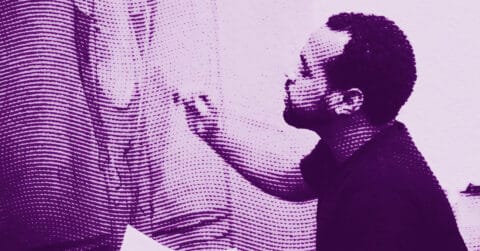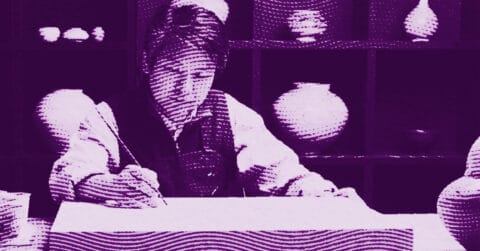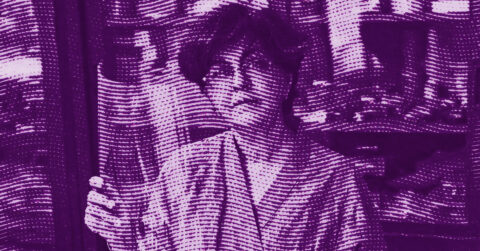Listen to me carefully, you bunch of snobs, Lynette Yiadom-Boakye (born 1977) shakes up figurative painting with a boldness that will leave you stunned. This British artist of Ghanaian origin bursts into our stuffy institutions like a punch in a Victorian portrait gallery. I will tell you why she is one of the most fascinating artists of our era, and why her work deserves your attention, whether you like it or not.
The first striking thing: she paints characters who do not exist. Yes, you read that right. In a world obsessed with the real, selfies, and forced authenticity, Yiadom-Boakye creates fictional beings with a technical mastery that would make Velázquez pale. Her imaginary portraits are more lifelike, more authentic than your retouched Instagram photos. That is where her genius lies: she makes us believe in the existence of people who have never existed.
Take “No Such Luxury” (2012), a monumental canvas that pulls you in as soon as you enter the room. A figure sitting before a cup of coffee stares at you with an intensity that pins you down. The character is there, undeniably present, yet completely free from social conventions, racial expectations, gender constraints. It is a masterful tour de force. As Serge Gainsbourg sang in “Je suis venu te dire que je m’en vais,” there is the same tension between presence and absence, between what is shown and what is suggested.
Yiadom-Boakye’s palette is a symphony of browns. She masters the shades like no one else, creating a depth that pulls you into her canvases. Her dark backgrounds are not there just for decoration; they are the stage where a silent drama unfolds, a meditation on existence itself. This is Sartre in painting, my friends, pure existentialism on canvas.
And then there is the way she plays with time. Her characters float in an eternal present, deliberately disconnected from any precise temporality. No shoes that might date the work, no accessories that would anchor it in an era. This is visual Proust, a search for pictorial time where past and present blend into the same eternity.
The titles of her works are poems in themselves, enigmatic and evocative like Rimbaud’s. “A Passion Like No Other”, “The Much-Vaunted Air”, “To Tell Them Where It’s Got To” are fragments of stories that exist only in our imagination. Just like in “La Javanaise”, where Gainsbourg plays with words to create an alternative reality, Yiadom-Boakye uses these titles as musical notes in a visual score.
But this is not just about aesthetics. Her work is deeply political, even though she refuses the role of standard-bearer that people want her to take on. By painting Black figures in the great tradition of European oil painting, she doesn’t ask for permission to enter the artistic canon; she takes her place there, period. This is Fanon in painting, a decolonization of the artistic imagination that does not bother with justifications.
Take “A Concentration” (2018), where four Black male dancers occupy the space with a grace that defies stereotypes. It is a stinging response to centuries of Western art where Black bodies were relegated to the margins. Like Simone de Beauvoir who deconstructed myths of femininity, Yiadom-Boakye deconstructs racial representations with devastating subtlety.
Her technique is impeccable. She masters chiaroscuro like the Dutch masters but subverts it for her own purposes. Her brushstrokes are assured, precise, without unnecessary embellishments. This is Cézanne on acid, painting that knows where it comes from but has no intention of staying obediently within prescribed boundaries.
Perhaps the most fascinating is her way of handling light. In works like “Complication” (2013), she creates atmospheres where luminosity seems to emanate from the characters themselves. It’s Caravaggio remixed for the 21st century, with a keen awareness of contemporary issues of representation.
What makes me boil is hearing some critics talk about her work solely in terms of identity. Yes, she paints Black figures. So what? Rembrandt painted Dutch people; no one reduces him to that. Her art transcends these easy categorizations, like a Gainsbourg melody transcends lyrics to reach something deeper.
Yiadom-Boakye is an artist who understands that painting is not dead, contrary to what some would have us believe. She breathes new life and new relevance into it. Like Nietzsche, who proclaimed the death of God to better affirm the need for new values, she proclaims the death of old pictorial codes to better reinvent painting.
What makes Lynette Yiadom-Boakye strong is her ability to create a parallel world that makes us doubt our own. Her imaginary characters are more alive than many portraits of real people. That is where her magic lies, in this ability to transcend reality to touch a deeper truth. Her paintings tell us they are there while reminding us of their fictitious nature, in a paradox that makes their power.
















